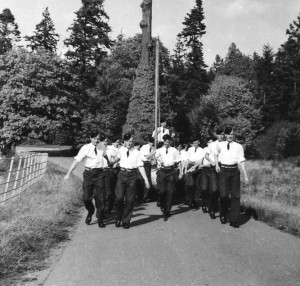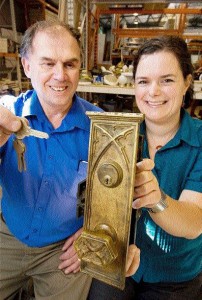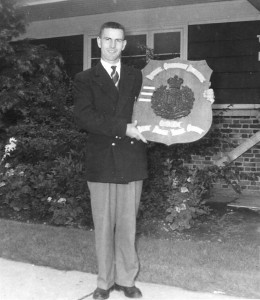Ex Cadet Documents Life at RRMC / Hatley Castle Artifacts
 After graduating from military college, 4906 Stanley (Stan) Franklin (RRMC RMC 1960) was a combat engineer with the Royal Canadian Engineers, and stayed in the army for 10 years, attaining the rank of Captain. He then pursued a career in civilian life working for Ontario Hydro, obtained an MBA and ended his career as manager of the Bruce site in Ontario, which was for many years the largest nuclear site in the world, producing about 6.450 megawatts of power. Stan kept a diary every day while he was a cadet at Royal Roads, and has put it together in book form, generously allowing Royal Roads University (RRU) to publish it as part of an initiative to preserve the military heritage of Royal Roads. All proceeds from the sale of the book will go to the Royal Roads Military Heritage Fund. See below for information about how to order the book, as well as a brief excerpt.
After graduating from military college, 4906 Stanley (Stan) Franklin (RRMC RMC 1960) was a combat engineer with the Royal Canadian Engineers, and stayed in the army for 10 years, attaining the rank of Captain. He then pursued a career in civilian life working for Ontario Hydro, obtained an MBA and ended his career as manager of the Bruce site in Ontario, which was for many years the largest nuclear site in the world, producing about 6.450 megawatts of power. Stan kept a diary every day while he was a cadet at Royal Roads, and has put it together in book form, generously allowing Royal Roads University (RRU) to publish it as part of an initiative to preserve the military heritage of Royal Roads. All proceeds from the sale of the book will go to the Royal Roads Military Heritage Fund. See below for information about how to order the book, as well as a brief excerpt.
by Karen Inkster,Royal Roads University
Karen: How did you come to write this book?
Stan: I had heard that [Royal Roads] was doing some work here on the military history of the place. And I had kept a diary since I was a teenager – every day – including when I was here, so I thought, well, I could easily write a little book or pamphlet or something on that and tell day by day what I did. I of course I didn’t have much time to write – anything. You’ll notice during exams I just wrote down, “calculus” – that would be the only thing for the day. Or “history” or whatever. But other days I would write down the different activities – sports, wins, losses, how I got in trouble – all those things. So then I just picked out the key words from the diary and expanded on those. So I think there are 80 or 90 little paragraphs in it which elaborate on different aspects of life here. And the other interesting thing is just as a result of just keeping a diary, I actually mention the majority of my classmates. Those I didn’t mention were likely in another squadron from the one I was in and we didn’t have quite so much to do with them except in competition so that’s how I did it.
Karen: So what did you notice about your time here as you were preparing the book?
Stan: Well the big thing was time management. We didn’t know that term at the time but we were scheduled for about 75 hours a week. We had 35 hours of classes and one spare during the week. We also had activities on Saturday morning, Sunday morning, and so it added up to a lot of time. You had to use every minute really to cope. And the big risk was failing academically. So you could lose a soccer game or you could make a mistake on parade but you couldn’t fail an exam. They didn’t have such a thing as supplemental exams. If you failed a final Christmas exam or a final annual exam you just…disappeared from Royal Roads. So that was a rather sad aspect of it because our friends who did fail academically just disappeared and we didn’t have a chance to say a proper goodbye to them. There were no farewell parties or anything like that.
Karen: I met some of your classmates and a lot of them seem like characters. Do you have any funny stories to share?
Stan: Well I’ll tell you one about 4954 Peter Robson (RRMC RMC 1960). He was a class joker and our librarian here was a Mrs. Campbell. The library was in the castle on the second floor I believe. So week nights different cadets had to be in charge of the library. This was one of the other things you had to do besides 75 hours a week and Peter was a duty librarian and he pulled two really interesting jokes on the librarian. One was he wrote in his report that he thought he heard mice in the ancient history section so the next day Mrs. Campbell had a whole crew of sailors in there taking out all the books, looking for the mice (chuckles). So that was cute. And the other thing was she had this rubber plant sitting on the front of her – on a table right in front of her desk. It was like a bit of pride and joy to her. So every time Peter was on duty he would pick one leaf off the rubber plant. And they didn’t have all that many leaves. So it was starting  to look a bit skimpy and he wrote in his report, “There seems to be something wrong with this rubber plant. I don’t know for sure but it seems to be losing its leaves.” Meanwhile he was leaving with a leaf in his pocket every time he was on duty. And then we did lots of skylarks which were just jokes that you did in the night. There was no way you could do anything in the daytime without getting caught so you were not allowed to leave your room at night but we would sneak out and do different things. In the book you can see the picture of the dinghy. We hauled that up from where you work at the boat house and put it on a parade square on a Saturday night and so when they were getting ready for the parade on Sunday morning, all of a sudden, ohhh panic! There’s a dinghy on the parade square and the parade square was sort of secret – like you didn’t mess around on the parade square. So that afternoon we had to haul the dinghy back and forth from the lagoon to the parade square. That was part of the punishment and for some reason we had to write an essay as well on clouds. I have no idea what that had to do with the skylark but those were a couple of jokes – one by an individual and another by quite a number of cadets.
to look a bit skimpy and he wrote in his report, “There seems to be something wrong with this rubber plant. I don’t know for sure but it seems to be losing its leaves.” Meanwhile he was leaving with a leaf in his pocket every time he was on duty. And then we did lots of skylarks which were just jokes that you did in the night. There was no way you could do anything in the daytime without getting caught so you were not allowed to leave your room at night but we would sneak out and do different things. In the book you can see the picture of the dinghy. We hauled that up from where you work at the boat house and put it on a parade square on a Saturday night and so when they were getting ready for the parade on Sunday morning, all of a sudden, ohhh panic! There’s a dinghy on the parade square and the parade square was sort of secret – like you didn’t mess around on the parade square. So that afternoon we had to haul the dinghy back and forth from the lagoon to the parade square. That was part of the punishment and for some reason we had to write an essay as well on clouds. I have no idea what that had to do with the skylark but those were a couple of jokes – one by an individual and another by quite a number of cadets.
Order a copy of “Cadet Life”
If you would like to order a copy of the book, please email RRU staff person, Karen Inkster: Karen.Inkster@royalroads.ca and request an order form. The cost of the book is $17.00, which includes GST and shipping costs. All proceeds from this book will be generously donated to the Royal Roads Military Heritage Fund.
Summary of “Cadet Life”
From the intimidating first arrival at the parade square in 1956 to the ceremonial graduation display in 1958, Officer Cadet Stanley Franklin wrote in his diary every day he spent at Royal Roads Military College. Often just a few words, the entries give an informative and sometimes humorous glimpse of cadet life at Royal Roads during the 1950s. In addition to the original diary entries, Mr. Franklin explains in retrospect some of the unique characteristics of the military college experience, ensuring that this important period of Royal Roads’ history is understood and preserved.
Excerpts from “Cadet Life”
Thursday, Sep 6, 1956 – “This is my first day at Royal Roads. What a welcome! Not a minute of spare time.”
10 Oct Wed – “Usual daytime routine. No time to spare but had fun at soccer.”
11 Oct Thu – “Practice for Wing Parade. I goofed up a Physics test.”
12 Oct Fri – “I goofed another Physics test. We are working at our white belts.”
White Belts We were issued soft, fawn-colored belts, which we turned into shiny, white ones by applying many coats of white rubber-based paint. We stored them on metal frames that were shaped like our waists. We handled the belts with great care to prevent the paint from cracking. If they cracked we had to sand out the crack and start painting them from scratch.
13 Oct Sat – “Football game. We won our 3rd straight. I wrote a letter home. I decided to fly to Seattle for Stand-down.”
14 Oct Sun – “We had to stand in the rain and watch ‘Ontario’ trim RR.”
15 Oct Mon – “First day of initiation. Hats on backwards. 7 circles. Through the halls backwards.”
Initiation Initiation of first year recruits lasted five days. Hazing was stepped up – for example, we were ordered to march backwards when inside all buildings. We had many more circles than usual. In defians, we all wore our hats on the wrong side of our heads when on parade. The Cadet Officers knew something was wrong about how we looked, but they didn’t figure out what was different.
16 Oct Tue – “7 circles again and out doing pushups at 2300 hrs.”
17 Oct Wed – “7 more circles. No time at all. Our last week as recruits.”
18 Oct Thu – “Doggy night. Leading Cadet Palmer had me swimming, crawling and rolling.”
Doggy Night This was a night of extra hazing when a senior took 1 or 2 juniors and gave them totally silly things to do. No one was physically hurt. I had to swim in the lake and crawl and roll on the hilly part of the lawn.
19 Oct Fri – “Initiation. Mud! Mud! How I enjoyed our first Mess Dinner.”
20 Oct Sat – “First leave in Victoria. I saw a show about Bodner. My what a slack bunch!”
21 Oct Sun – “Busy as hell! Wing Parade. From now on no more Saturday nights in Victoria.”
22 Oct Mon – “Back to the grind. Things are getting better though.”
23 Oct Tue – “This is our first week of #5’s. We look more like cadets.”
Everyday Uniforms Our new uniforms (# 5’s) included navy blue battledress jackets and blue trousers with a red stripe up the legs. They looked much better than the dungaree jackets and pants that we had worn until now. Since the navy blue showed every piece of Froust, we had a “brushing partner” with whom we brushed before every parade.
_______________________________________________________________________________
 Royal Roads is interested in acquiring all heritage artifacts, including
Royal Roads is interested in acquiring all heritage artifacts, including
photographs and documents, that add to the collection of the National
Historic site of the former military college and the grand home and
castle designed by British Columbia coal baron Robert Dunsmuir. Several
items from the castle, including chandeliers, furniture and other
fixtures, were auctioned off during the 1940s. An antique door knob and
lock set, cast from either brass or bronze, was likely replaced during
renovation work at the castle during the tenure of the Department of
National Defence, according to RRU staff who consulted with heritage
experts. The door handle will go into RRU’s heritage inventory to be
used if needed for castle repair work. Doug Pletsch, director of
physical and environmental resources at Royal Roads. “These are one-of-a
kind fixtures, so if we ever have to replace them, it’s difficult and
expensive because they have to be custom crafted. It’s nice to have an
extra.” Pletsch said the university is also on the lookout for one of
the mirrors that once hung in the castle drawing room when the estate
belonged to James and Laura Dunsmuir.

